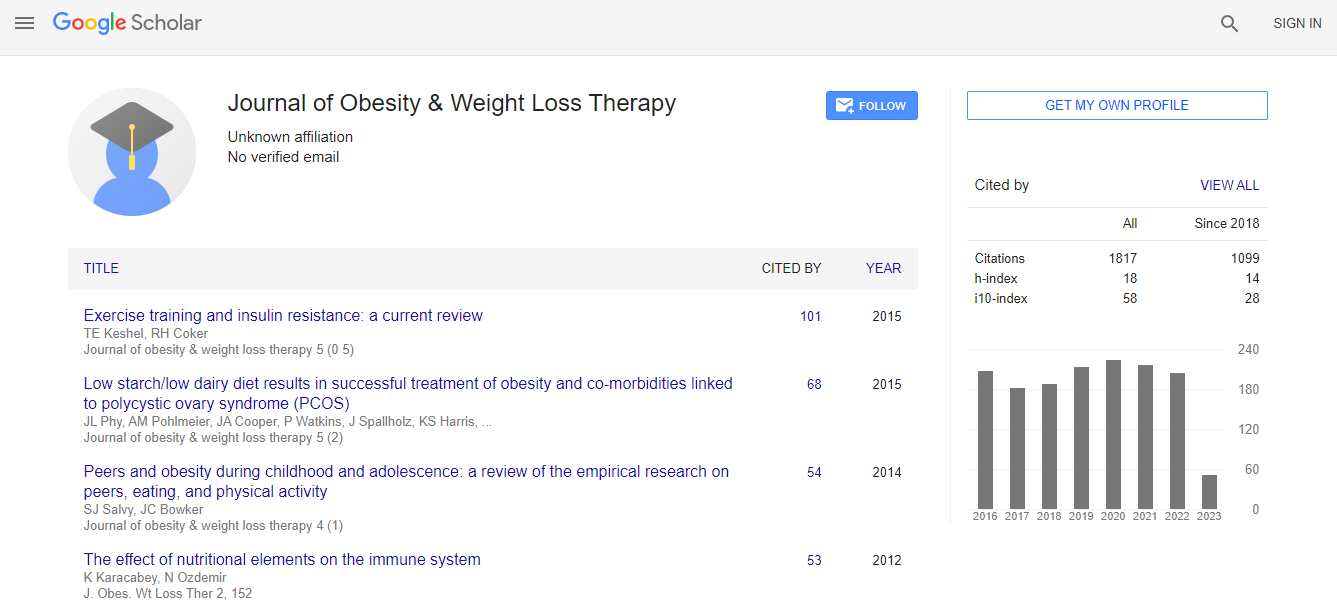Our Group organises 3000+ Global Conferenceseries Events every year across USA, Europe & Asia with support from 1000 more scientific Societies and Publishes 700+ Open Access Journals which contains over 50000 eminent personalities, reputed scientists as editorial board members.
Open Access Journals gaining more Readers and Citations
700 Journals and 15,000,000 Readers Each Journal is getting 25,000+ Readers
Google Scholar citation report
Citations : 2305
Journal of Obesity & Weight Loss Therapy received 2305 citations as per Google Scholar report
Journal of Obesity & Weight Loss Therapy peer review process verified at publons
Indexed In
- Index Copernicus
- Google Scholar
- Open J Gate
- Genamics JournalSeek
- Centre for Agriculture and Biosciences International (CABI)
- RefSeek
- Hamdard University
- EBSCO A-Z
- OCLC- WorldCat
- SWB online catalog
- CABI full text
- Cab direct
- Publons
- Geneva Foundation for Medical Education and Research
- Euro Pub
- University of Bristol
- Pubmed
- ICMJE
Useful Links
Recommended Journals
Related Subjects
Share This Page
Biochemical and hematological factors in obsess addicted men with focus on the triglyceride and cholesterol homeostasis in obsess addicted hamsters
6th World Congress on Obesity
Ebrahim Abbasi Oshaghi and Fatemeh Mirzaei
Hamadan University of Medical Sciences, Iran Kermanshah University of Medical Sciences, Iran
Posters & Accepted Abstracts: J Obes Weight Loss Ther
Abstract
This experiment was planned to study the effect of opium on biochemical and hematological factors in human and hamsters with focus on cholesterol and triglyceride hemostasis via LXR alpha. Normal and high cholesterol diet (HCD) addicted Syrian golden hamsters were used in this study. Biochemical and hematological factors were measured after one month. The mRNA and protein levels of LXR were determined by RT-PCR and western blotting, respectively. Histological changes of liver and intestine were examined by a light microscope. For human study, biochemical and hematological parameters were determined for 500 male (250 addicts and 250 controls). GC-Mass spectrometry of opium showed presence of about 30% alkaloids (morphine 16%, thebaine 4.4%, papaverine 3.2%, and codeine 5.5%) and the rest was non-alkaloidal agents, inorganic material and 13.5% water. Opium changed some biochemical, hematological and antioxidant test in human and hamsters (P<0.05). The mRNA and protein levels of intestinal LXR were significantly increased in addicted animals in comparison with non-addicted (P<0.05). The mRNA and protein levels of liver LXR were significantly increased in HCD and HCD+ opium group (P<0.05). Opium consumption also, produced severe injuries in the intestine and liver of hamsters. Our findings indicated that opium reduced total cholesterol, probably via LXR expression in hamster. However, opium also increased the level of malondialdehyde, triglyceride, platelet, and reduced total antioxidant capacity and white blood cell.Biography
Email: 7abbasi@gmail.com

 Spanish
Spanish  Chinese
Chinese  Russian
Russian  German
German  French
French  Japanese
Japanese  Portuguese
Portuguese  Hindi
Hindi 
